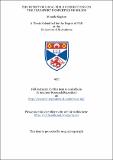Files in this item
The effect of local field corrections on the transport properties of solids
Item metadata
| dc.contributor.advisor | Friedman, Lionel Robert | |
| dc.contributor.author | Saglam, Mesude | |
| dc.coverage.spatial | 182 p. | en_US |
| dc.date.accessioned | 2018-06-26T10:13:11Z | |
| dc.date.available | 2018-06-26T10:13:11Z | |
| dc.date.issued | 1977 | |
| dc.identifier.uri | https://hdl.handle.net/10023/14591 | |
| dc.description.abstract | The purpose of this work is to investigate local field type corrections to electrical transport properties and in particular small polaron hopping conductivity. The question of local field corrections to transport properties has been considered for some time. Recently this question has become of particular interest for small polaron hopping conduction. Such corrections were considered as a possible explanation for the large jump parameters inferred in fitting the electric field dependence of the electrical conductivity of certain transition metal oxide glasses in which conduction is believed to occur via thermally activated small polaron hopping. Local field corrections are well established in determining the dielectric constant and optical properties at a single atomic site. Tessman et al have shown that the assumption of a normal Lorentz term gives excellent agreement between computed and measured polarizabilities in alkali halide crystals at optical frequencies. Adler has proved, using a self-consistent field theory that the standard Lorentz term arises in the tight binding limit. Also a full quantum mechanical treatment of the frequency and wave-number dependent dielectric constant including local field effect has been given by Wiser. It is shown that the dielectric constant splits into an atomic term that describes the motion of the electron around each atom and an acceleration term which describes the motion from atom to atom and that acceleration term contains no local field correction. Lidiard has discussed Lorentz type corrections to the diffusion coefficient in ionic conductivity. He argued that no Lorentz correction should be applied, since the Lorentz cavity must always be centred on the hopping carrier; thus, the Lorentz internal field can do no work as the carrier moves from one site to another. This view is strongly supported by the close agreement between ionic diffusion coefficients obtained from conductivity data and NMR relaxation and isotopic diffusion. It has been argued by Munn in several papers without detailed justification that the microscopic mobility does give the polaron velocity in terms of a local field. This argument is in conflict with that of Lidiard. However this question had not been considered explicitly for the case of electrical transport in the hopping limit. It is the intent of the present work to study the local field problem. In the first chapter we give a general description of the local electric field concept which is straight review. Chapters II and III are concerned with the question of local field corrections to the small polaron hopping conduction and the Hall mobility. In Chapter IV the results of Chapter II are applied to ac impurity hopping conduction. Finally in Chapter V we study the band motion of electrons using a theory of transport based on quantum mechanical principles. | en_US |
| dc.language.iso | en | en_US |
| dc.publisher | University of St Andrews | |
| dc.subject.lcc | QC176.8E4S2 | |
| dc.subject.lcsh | Energy-band theory of solids | en |
| dc.title | The effect of local field corrections on the transport properties of solids | en_US |
| dc.type | Thesis | en_US |
| dc.contributor.sponsor | Turkey. Ministry of Education | en_US |
| dc.type.qualificationlevel | Doctoral | en_US |
| dc.type.qualificationname | PhD Doctor of Philosophy | en_US |
| dc.publisher.institution | The University of St Andrews | en_US |
This item appears in the following Collection(s)
Items in the St Andrews Research Repository are protected by copyright, with all rights reserved, unless otherwise indicated.

